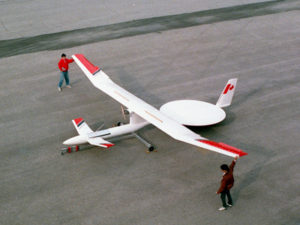April 2018 – Volume 20, Issue 3
In This Issue
Flanigan’s Eco-Logic
Quote of the Week
Hitting 50% Solar in California
IEA Reports Dramatic Rise of Renewables
The Duck at 10… now “the Dragon Curve”
Prop 39’s Five-Year Conclusion
Wireless Electricity
Copenhagen’s Energy Transformation
John Gravelin Joins the EcoMotion Team
We’re Hiring!

Flanigan’s Eco-Logic: The End of Baseload Power!
Memories from my childhood growing up in New York City; memories from “67th and Lex.” Across the East River… the three iconic orange and white stacks of “Big Alice.” Technically “Big Allis,” a tribute to its builder, the Allis-Chalmers Corporation, it was the largest power plant in the world when it was built, generating a million watts! As a child it seemed that you could feel its pulse… the beat of non-stop urban energy, shaking New York’s granite core.
That’s baseload power. Lots of it. It never stops. It’s 24*7. It powers traffic and railroad signals, it powers emergency exit signs, it powers stairway lighting, water systems, and a million other constant uses. In California, a typical daily utility load profile looks like Mt. Everest. Our baseload requirement is about 10 GW, equivalent to the output of ten large nuclear reactors. What happens above baseload energy is constantly changing, by time, by weather, by seasons.
This newsletter features a rather shocking story on the “ducks and dragons.” California generates huge amounts of solar electrons. Some say we are “over-generating” solar. The net result is that our Mt. Everest of demand is clipped. The load profile – net of solar – is like a crater. Solar has ripped off Everest’s summit. This resulting load profile is known as “the duck curve.”
I scoff when I hear that California has all the solar it can take. Like lemmings infatuated with the Duck Curve, we surrender at its mention. Are we really suffering from solar “over-generation?” We should be celebrating the first major accomplishment on our path to a carbon-free power system.
Of course we should be generating lots of solar power; the sun is our abundant renewable here in California. Just as we take hydroelectricity from the Northwest, how about sending some of our excess solar out of state? Storage and complementary renewables may well render the Duck Curve an obsolete system planning construct.
The duck is sitting in a sea of obsolete baseload power plants. Soon these old dogs will be retired and the duck will sink even lower in solar success. We now need to deploy renewable capacity that can ramp up and down with alacrity. Offshore wind may be ideal. Then we complement the renewables with the suite of efficiency services (conservation, efficiency, load management, and demand response) plus energy storage from vehicles and “classic,” stationary sources. Rather than dissing solar, these are the next big portfolio steps.
Quote of the Week
Hitting 50% Solar in California
Indeed, it was a cool, sunny day in Spring. March 4th, a Sunday when peak demand is low. But on that day at 12:58 PM, solar energy provided 49.95% of the California’s power requirement. That eclipsed a prior record of 47.2% set in May 2017. As reported by the California Independent System Operator (CAISO), on March 4th the load was 18,800 MW and solar production was ~9,400 MW.
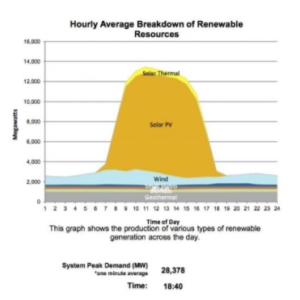
CAISO Overall Renewables Production for March 5, 2018
The very next day, solar set a new record, providing 9,913 MW to the California grid. That same day the California Independent System Operation (CAISO) managed a record-fast “ramping up” of other resources when the sun went down. It achieved a three-hour ramp of 14,777 MW, and a one-hour ramp of 7,545 MW.
California’s big three investor-owned utilities (IOUs) are on track to fulfill the required amounts of renewables that they have to procure and deliver. The Renewable Portfolio Standard (RPS) target for these utilities is 33% by 2020. According to their annual RPS Compliance filings, PG&E is currently at 32.9%, SCE 28.2%, and SDG&E 43.2%. The IOUs are buying lots of renewables, and so are Community Choice Aggregation (CCA) providers. Experts now anticipate that the IOUs won’t be buying more any time soon; they’ll be holding off on additional renewable purchases given their aggressive purchases compounded with departing loads to CCAs.
IEA Reports Dramatic Rise of Renewables
 The Paris-based International Energy Agency (IEA) was founded after the 1973 oil crisis. The IEA is known as a conservative institution. Now it reports that renewable resources are catching up with coal… catching up and poised to eclipse coal as the world’s largest source of electricity.
The Paris-based International Energy Agency (IEA) was founded after the 1973 oil crisis. The IEA is known as a conservative institution. Now it reports that renewable resources are catching up with coal… catching up and poised to eclipse coal as the world’s largest source of electricity.
Right now, 22% of world’s electricity comes from clean sources, predominantly hydro, wind, and solar. Currently, coal supplies 29% of the global energy mix. By 2018, renewables will surpass natural gas power generation, and will produce twice as much as nuclear plants. China’s total energy mix is 40% renewables, one of the highest percentages in the world. Denmark is leading the way among the nations of the world, generating 44% of the nation’s power requirement with renewables. By 2022, Denmark plans to get 77% of its power from renewables.
The IEA reports that 700 GW of renewables will be added in next five years. By 2020, 26% of the world’s electricity will be generated from renewables. By 2022, renewables will provide 30% of worldwide power generation. IEA calls the dramatic rise in global renewables “a remarkable shift in a very limited period of time.”
Hydroelectricity provides the most renewable generation; solar has experienced the fastest rate of growth. But solar “capacity” is a bit deceptive since solar only provides the resource when the sun shines. Only a portion of a solar system’s nameplate capacity turns into electricity. IEA defines intermittent sources as “Variable Renewable Energy,” resources that can’t be switched on and off as needed.
The Duck at 10… now “the Dragon Curve”
California Governor Jerry Brown has a goal of having 5 million zero emission vehicles on California’s roadways by 2025. This will require 200,000 – 300,000 new EV chargers and could result in a 1 GW increase in peak demand in the Golden State. Beyond that, EV charging could transform “the duck curve” into a “dragon curve.”
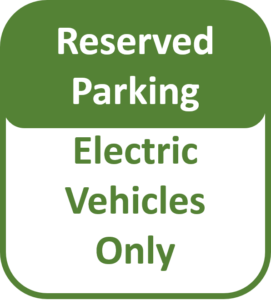
The Duck Curve was first recognized by National Renewable Energy Laboratory (NREL) scientists in 2008. It graphically depicted how supply and demand would be affected by theoretical high solar growth. Researchers projected that “the Duck Curve” would begin to take shape when solar reached 10% of the grid, now we’re nearly 30%. Net of solar, the sharp evening demand spike looked like a duck’s neck and bill.
This pesky power system reality – now ten years old – is so pronounced and acknowledged that it is changing the peak time of use periods for each of California’s three major investor-owned utilities. Summer peak periods will now shift from afternoon, to late afternoon and early evening. For instance, Southern California Edison’s peak will be 4 – 9pm; PG&E’s peak will be 5 – 10pm!
The Duck Curve requires a new way of operating the power system. Some call it “fattening and flattening” the duck. Fatten it with additional and complementary renewables; flatten with demand-side management, notably “managed EV charging” plus advanced energy storage and demand-side management.
Now system planners are considering a new phenomenon, a new curve… the Dragon Curve. This is the result of adding lots of electric vehicles (EVs) to the grid. Despite smart charging that allows for off-peak charging, California’s peak demand will be at least 1 GW greater by 2025.
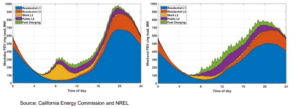
The Dragon Curve
Source: California Energy Commission and NREL
The weekday Dragon Curve, depicted on the left, includes a bump in workplace charging demand during weekday mornings and a steep ramp up in evening power due to more residential charging. Governor Brown’s executive order calls for $2.5 billion of cap and trade funds for EV charger deployment. On weekends, the morning bump is removed, but in both scenarios the presence of fast DC charging creates a bumpy load profile.
Prop 39’s Five-Year Conclusion
Last week I attended at the School Energy Coalition Spring Summit in Sacramento. I was tasked with presenting EcoMotion’s implementation experience with PERCs, Powered Emergency Response Centers. PERCs are a poignant spin-off of Prop 39 planning activities. Well beyond the intended scope and retrofits of Prop 39, EcoMotion is developing microgrids and PERCs on California campuses.

EcoMotion has built six PERCs in Monterey County. It was a pleasure to be in Sacramento presenting and promoting the update to the model: SEC has been, and continues to be, a powerful advocate of school and community college energy efficiency, beating the drum to substantiate success and seek further funding for smart energy management.
The last Prop 39 Energy Expenditure Plans were submitted by the K-14 community on February 26th of this year. This allowed the California Energy Commission the chance to tally all expenditures, and we hope, to regroup and prepare for program continuation.
The good news is that 94% of the funds have been used or are formally earmarked for projects. Fully $1.748 billion was allocated by the legislature to the five-year program, an average of $379.6 million per year. All that remains is $114.5 million. Overall, 98% of public school districts applied for funds; 66% of charter schools applied for funds… many ineligible given their short existence and/or leased facilities.
We can now say that Prop 39 was indeed fully subscribed, popular, and impactful. As Anna Ferrera, SEC’s Executive Director, remarked, “In the end, we really did come through.” Schools took full advantage of the program and have never been as attuned to their energy use as there are now. Energy is one of schools’ largest controllable costs. Naturally there would be no rationale for program extension if Prop 39 funds were not fully tapped.
The flip side of this, the bad news for our clients, is that there are no “remainder funds” for additional retrofits. Instead, unallocated funds will go into competitive Bus Replacement Program grants and Energy Conservation Act Assistance (ECAA) loans; $75 million for buses and the next $100 million to ECAA.
So long story short, Prop 39 is now unfunded despite the fact that Senator Kevin de Leon was successful in eliminating its sunset date. The Clean Energy Jobs Act can serve as a viable “receptacle” for subsequent funding. The tax loophole closure that funded Prop 39 is still in place, but there is no defined path forward at this time for continued funding.
Through Prop 39’s investments in our schools, energy and dollar and environmental savings will not only be realized at California schools, but also throughout our communities as young students take the Prop 39 message home and carry the efficiency mantra with them throughout their lives.

At EcoMotion, Prop 39 was a fantastic emphasis of our work. Overall, we represented eight school districts and eight charter schools with 181 campuses when combined. Half of this work was in partnership with Climate Resolve, a non-profit dedicated to local climate solutions. For each district and school, we prioritized retrofit activities and charted optimal courses for smart energy management. By the end of the program, we’d worked on 75 campuses. In some cases, we managed complete retrofits of schools’ HVAC and lighting systems. In other cases, we added solar and storage. Overall, we were responsible for nearly $24 million in this preferential funding, and got a lot done… measures that will cut costs and carbon while improving the quality of California campuses.
Most of the retrofit work is now done. Lighting retrofits were conducted at 37 sites – a tally of 14,384 fixtures – including exterior fixtures, parking lot and stadium lighting, LED classroom fixtures, and exit signs. HVAC replacements were done at 21 sites; 263 units were replaced. Energy management upgrades were done at 58 sites and included retro-commissioning, student-facing dashboards, and wireless thermostat systems. Solar systems were installed at 32 sites resulting in combined capacity of 2,650 kW. Energy storage was installed at 25 sites with 1,620 kW of capacity. Pool equipment was upgraded at 13 sites and included efficient pumps, variable frequency drives, heaters, and pool covers.
Other activities were made possible thanks to Prop 39’s structure, notably its Planning Funds that allowed districts to explore a wide breadth of energy management functions, sometimes leveraging other resources. For Garden Grove Unified School District, EcoMotion helped win a $1.9 million grant for drought-resistant planting and bioswales from the State Water Resources Control Board. We crafted proposals and were awarded two Zero Net Energy pilot programs managed by Southern California Edison and Southern California Gas, in the first case transforming a high school science wing into a state-of-the-art facility. In another case, we helped an inner-city charter school get an electric bus and charging gear through a grant application opportunity.

Thanks to Santa Rita Union School District in Monterey County, EcoMotion developed a highly innovative Power Outage Protection Program. This led to the PERC concept: Powered Emergency Response Centers that provide unparalleled levels of energy resilience to California campuses. For SRUSD, EcoMotion developed a new means of creating and financing carbon-free microgrids that allow students to shelter in place during short-term outages, and that become community assets for first responders in the event of prolonged power outages. Working with Campbell Union High School District in San Jose, EcoMotion is now developing a template for “rewiring” California campuses such that their solar assets – when combined with storage and controls – are vital during power outages.
Wireless Electricity
Imagine using lasers of light to beam energy to photovoltaic receivers on planes. The light energy is converted to current by photovoltaics on board the planes, creating on-board power to sustain flight.
This is not a pipe dream, but a proven form of wireless power transfer: In the 1980s, Canada’s Communications Research Centre created a small airplane that ran off power beamed from Earth. The unmanned plane named Sharp could fly for months at a time. NASA has also developed long-distance power sources for unmanned planes. Scientists at the Marshall Space Flight Center used invisible, infrared lasers to activate solar cells on a small airplane.
Wireless electricity is coming. Read: Wireless electricity is here. Just as phones have been shed their cords, someday all appliances may too be wireless. No more dusty tangles of power strips and errant cords!
Wireless electricity is not a new concept at all. Nikola Tesla had a vision of wireless electricity. He even had a vision of a global wireless power grid. Tesla worked on this in the late 1800s and early 1900s, culminating with a demonstration at his lab in Colorado Springs that lit a light bulb using a “Tesla coil” across the stage. His dream is now becoming a reality.
Today, there are two fundamental forms of wireless power transfer: non-radiative and radiative. In non-radiative applications, power travels short distances. Radiative applications use lasers and microwaves for longer-distance applications.
The most basic form of non-radiative power transfer involves inductive charging applications. Think toothbrushes, charging stations for laptops at coffee chops, and implantable medical devices. Edison Electric’s Powerdesk and the Splashpower mat work without conductors touching one and other. Yet their range is very low.
In terms of distance, a step up from inductive charging is resonance. In December 2017, the Federal Communications Commission approved the first wireless power-at-a-distance charging system. A company called Witricity offers wireless EV charging… just park and charge. In this instance, a transmitter refills batteries from three feet away.
According to Witricity, “We’re not actually putting electricity in the air. We’re putting magnetic fields in the air use a source resonator.” Power is transferred with the same kinds of fields as Wifi routers. According to CNN in 2014, “In the house of the future, wire-free energy transfer could be as easy as wireless internet source.” In that scenario, smartphones will recharge as you wander around, EVs will refuel while sitting in the driveway.
The second form of wireless power transfer is “far-field” or “radiative” also known as “power beaming.” In these applications, power is transferred by beams of microwaves and lasers. These systems can transfer power for longer distances but must be carefully aimed at receivers to collect the power, for instance, on solar-powered satellites. Key to the development of this technology will be safeguarding human life.
Copenhagen’s Energy Transformation
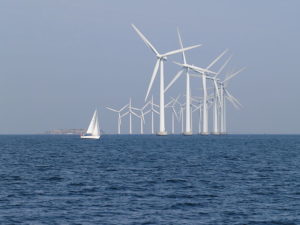
Middelgrunden Wind Farm
The Copenhagen harbor has been a pioneering energy center for some time. For years, the City’s state-of-the-art coal plant stood proud and large with an innovative front-end trash-burning plant. In summer, Denmark was importing cheap nuclear power from Sweden and using the trash plant to provide district heating for domestic hot water. Beyond the plant are the twelve towers of the Middelgrunden Wind Farm, a magnificent community-owned asset.
Copenhagen has pledged to be carbon-free by 2025, taking the lead as the world’s greenest city. Its action speaks volumes: a sustainable and highly innovative piece of architecture is the Amager Resource Center (ARC). The trash-burning plant is being remodeled in a really unique way by the Bjarke Ingels Group (BIG).
The goal has been to redefine the relationship between the waste plant and the City. BIG wanted to move away from the industrial, monolithic power plant look. Instead, the ARC waste-to-energy plant is a state-of-the-art green power plant scheduled to open this year. Clad in shiny aluminum, surrounded by park land, instead of belching smoke, it will blow smoke rings!
The trash-burning plant’s iconic roof features Europe’s largest, artificial ski hill. Elevators through the plant take skiers to the top of a 1,969-foot slope with both beginner and intermediate runs. A 591-foot black run pitches to as much as 45 degrees. The plant also includes a café and the world’s tallest artificial climbing wall. The recreation area around the plant includes water sports, a soccer field, a jogging trail, and a go-kart track.
Meanwhile, the $643 million plant will burn 400,000 tons annually, enough to power 62,500 homes and provide hot water to 160,000 homes in the Danish Capitol. It is dubbed the most efficient trash burning plant in the world, generating 25% more energy and emitting 100,000 fewer tons of CO2.
ARC is just one innovation in Copenhagen. Opened in 2010, the Adelgade cooling plant is sheltered in the brick clad shell of a retired power plant, and constitutes the country’s first district cooling network. It draws cool water from an intake pipe near Nyhavn Canal.
Transport continues to be a great challenge for Copenhagen. Fully 22% of City’s emissions come from transport. Now the City has a goal for 75% of all trips to be made by foot, on bike, or using public transit. The City is already known for biking even in inclement weather. More than 20,000 bicycles enter the city center during business hours. Denmark’s first, 11-mile bike superhighway was built in 2012.
Copenhagen is a City of a half million people. It has the world’s largest district heating network. Efficiency gains are planned to complement the district heating and district cooling works. There are goals in place to reduce residential and commercial energy intensities by 10 and 20 percent respectively, with total heat consumption to fall by 20% by 2025. The City has significant energy efficiency challenges with many old buildings built pre-standards. And it is not exempt from the classic split incentive between landlords and tenants.
The City currently emits about 2 million tones GHG per year. To achieve carbon neutrality, Copenhagen intends to replace coal with biomass. The Amager and Avedore plants, which today burn coal plus limited amounts of imported biomass, will replace coal entirely with wood chips and straw certified sustainable by the Danish Energy Association. Copenhagen will also build 100 wind turbines, and send the power elsewhere in Denmark, using offsets to address its transportation footprint.
John Gravelin Joins the EcoMotion Team
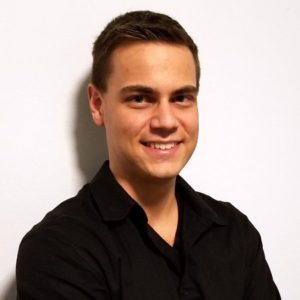
EcoMotion is pleased to announce that John Gravelin has joined the EcoMotion team. A Vermont native and graduate of the Boston Architectural College, and after seven years working as a Sustainability Consultant in Cambridge for Linnean Solutions, John has made the big trek west and brings his talents and energy to EcoMotion.
John received his bachelor’s degree in Design Studies and Architectural Technology from the Boston Architectural College. He has graduate certificates in Sustainable Design and in Sustainable Community Planning and Design. John is the son of a contractor, is an avid and accomplished photographer. He has a keen sense of design and is LEED certified.
John is already proving valuable by supporting two new projects at EcoMotion. Working closely with the solar team, he’s knee-deep in an analysis of the City of Chino’s solar potential on its municipal properties. He’s also spearheading a comprehensive bill analysis for Point Loma Nazarene University where EcoMotion is analyzing the efficacy of 180 electricity accounts, two solar Power Purchase Agreements, and 40 direct access accounts.
We’re Hiring!
EcoMotion is hiring a Business Development Director. Duties will include strategic positioning, tracking prospects, proposal development, and service sales. Applicants must have strong written and oral communication skills and be enthusiastic about our region’s transition to a carbon-free, higher quality of life. For more information or to submit cover letter and resume, please email Michele Baldi at MBaldi@EcoMotion.us

